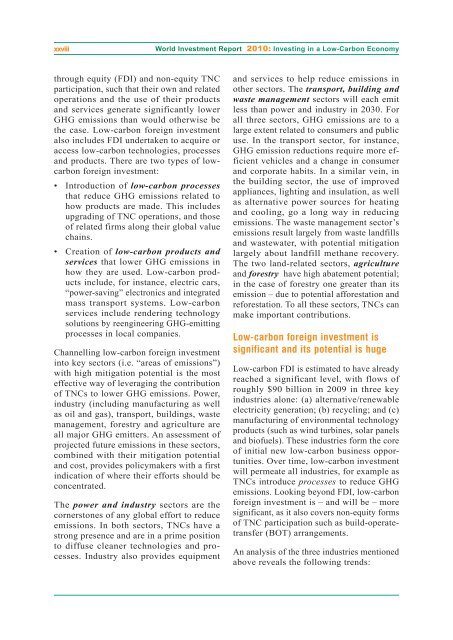UN World Investment Report 2010 - Office of Trade Negotiations
UN World Investment Report 2010 - Office of Trade Negotiations
UN World Investment Report 2010 - Office of Trade Negotiations
You also want an ePaper? Increase the reach of your titles
YUMPU automatically turns print PDFs into web optimized ePapers that Google loves.
xxviii<br />
through equity (FDI) and non-equity TNC<br />
participation, such that their own and related<br />
operations and the use <strong>of</strong> their products<br />
and services generate significantly lower<br />
GHG emissions than would otherwise be<br />
the case. Low-carbon foreign investment<br />
also includes FDI undertaken to acquire or<br />
access low-carbon technologies, processes<br />
and products. There are two types <strong>of</strong> lowcarbon<br />
foreign investment:<br />
• Introduction <strong>of</strong> low-carbon processes<br />
that reduce GHG emissions related to<br />
how products are made. This includes<br />
upgrading <strong>of</strong> TNC operations, and those<br />
<strong>of</strong> related firms along their global value<br />
chains.<br />
• Creation <strong>of</strong> low-carbon products and<br />
services that lower GHG emissions in<br />
how they are used. Low-carbon products<br />
include, for instance, electric cars,<br />
“power-saving” electronics and integrated<br />
mass transport systems. Low-carbon<br />
services include rendering technology<br />
solutions by reengineering GHG-emitting<br />
processes in local companies.<br />
Channelling low-carbon foreign investment<br />
into key sectors (i.e. “areas <strong>of</strong> emissions”)<br />
with high mitigation potential is the most<br />
effective way <strong>of</strong> leveraging the contribution<br />
<strong>of</strong> TNCs to lower GHG emissions. Power,<br />
industry (including manufacturing as well<br />
as oil and gas), transport, buildings, waste<br />
management, forestry and agriculture are<br />
all major GHG emitters. An assessment <strong>of</strong><br />
projected future emissions in these sectors,<br />
combined with their mitigation potential<br />
and cost, provides policymakers with a first<br />
indication <strong>of</strong> where their efforts should be<br />
concentrated.<br />
The power and industry sectors are the<br />
cornerstones <strong>of</strong> any global effort to reduce<br />
emissions. In both sectors, TNCs have a<br />
strong presence and are in a prime position<br />
to diffuse cleaner technologies and processes.<br />
Industry also provides equipment<br />
<strong>World</strong> <strong>Investment</strong> <strong>Report</strong> <strong>2010</strong>: Investing in a Low-Carbon Economy<br />
and services to help reduce emissions in<br />
other sectors. The transport, building and<br />
waste management sectors will each emit<br />
less than power and industry in 2030. For<br />
all three sectors, GHG emissions are to a<br />
large extent related to consumers and public<br />
use. In the transport sector, for instance,<br />
GHG emission reductions require more efficient<br />
vehicles and a change in consumer<br />
and corporate habits. In a similar vein, in<br />
the building sector, the use <strong>of</strong> improved<br />
appliances, lighting and insulation, as well<br />
as alternative power sources for heating<br />
and cooling, go a long way in reducing<br />
emissions. The waste management sector’s<br />
emissions result largely from waste landfills<br />
and wastewater, with potential mitigation<br />
largely about landfill methane recovery.<br />
The two land-related sectors, agriculture<br />
and forestry have high abatement potential;<br />
in the case <strong>of</strong> forestry one greater than its<br />
emission – due to potential afforestation and<br />
reforestation. To all these sectors, TNCs can<br />
make important contributions.<br />
Low-carbon foreign investment is<br />
significant and its potential is huge<br />
Low-carbon FDI is estimated to have already<br />
reached a significant level, with flows <strong>of</strong><br />
roughly $90 billion in 2009 in three key<br />
industries alone: (a) alternative/renewable<br />
electricity generation; (b) recycling; and (c)<br />
manufacturing <strong>of</strong> environmental technology<br />
products (such as wind turbines, solar panels<br />
and bi<strong>of</strong>uels). These industries form the core<br />
<strong>of</strong> initial new low-carbon business opportunities.<br />
Over time, low-carbon investment<br />
will permeate all industries, for example as<br />
TNCs introduce processes to reduce GHG<br />
emissions. Looking beyond FDI, low-carbon<br />
foreign investment is – and will be – more<br />
significant, as it also covers non-equity forms<br />
<strong>of</strong> TNC participation such as build-operatetransfer<br />
(BOT) arrangements.<br />
An analysis <strong>of</strong> the three industries mentioned<br />
above reveals the following trends:

















